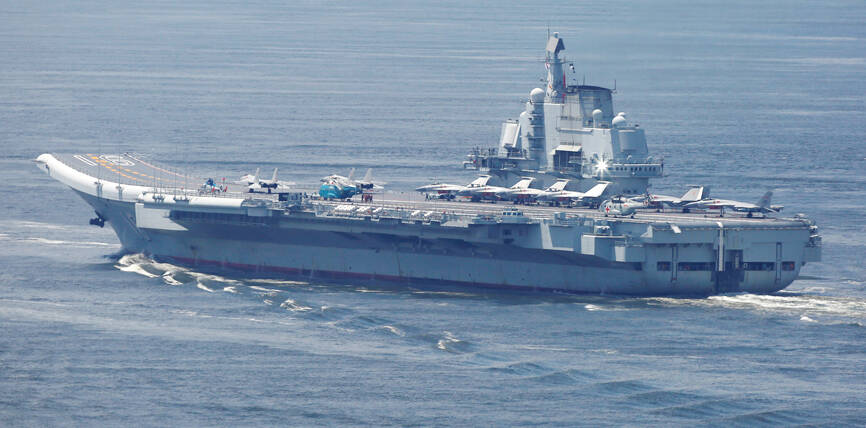China is increasingly likely to employ a strategy of anti-access/area denial (A2/AD) around Taiwan, which would use three carrier groups, a report from the Mainland Affairs Council (MAC) said.
When China’s third aircraft carrier, the Fujian, is completed next year, China would have three carriers, which would likely be used to surround Taiwan and implement an A2/AD strategy, it said, adding that efforts to strengthen China’s two other carriers — the Liaoning and the Shandong — appear to corroborate this.
In the quarterly report, the council cited declassified documents from the Ministry of National Defense that categorized China’s carriers as a threat if used for A2/AD, and said that China might coordinate its naval, air force and rocket force capabilities to operate beyond the first island chain and deter foreign forces from getting involved in a conflict involving Taiwan.

Photo: Reuters
The Chinese People’s Liberation Army (PLA) Rocket Force would deploy medium and long-range conventional ground-attack and anti-ship ballistic missiles, and cruise missiles to foreign forces in the area between the first and second island chains, it said.
Citing military researchers, the report said that in the event of an attempted invasion of Taiwan, Chinese forces would likely first take formation in the northern part of the Philippine Sea, somewhere between 300km and 800km east of Taiwan proper. This posture would allow China to face Taiwan simultaneously on two fronts, with forces east of Taiwan also acting as a deterrent to foreign forces, it said.
Separately, Institute for National Defense and Security Research fellow Su Tzu-yun (蘇紫雲) on Sunday said that China’s three carriers are part of China’s transition from a land power to a sea power.
The introduction of the Fujian into service would help make the PLA Navy a “blue water navy,” and allow China to more effectively encircle Taiwan, he said.
The range of Taiwan’s Xiangfeng missiles is 200km to 250km, so China’s carriers would be deployed 300km or more east of Taiwan, putting them out of range, he said. Meanwhile, the range of the fighter jets that would be deployed from the carriers is about 800km, so an attack on Taiwan could be launched from within a safe range.
Taiwan can use anti-ship missiles to attack approaching enemy ships, but must rely on submarines to deal with long-distance aircraft, he said, adding that domestically-built submarines are important.
In the event of a war, it would be difficult for Chinese aircraft to safely pass through the Bashi Strait or Miyako Strait, he said, adding that if the US were to help Taiwan, China’s aircraft carriers in waters east of Taiwan would be “sandwiched” between attacks from both sides.
Within the strategic triangle comprised of Hawaii, Guam and Taiwan, Chinese carriers would become the target of the US military, he said.
“Thoughts to the contrary are simply wishful thinking on the part of the Chinese,” he said.
Chinese aircraft carriers stationed east of Taiwan during an attack would also be subject to a war of attrition since they would need supplies within one to two weeks, he said.
“Since the passage of supply ships through the Bashi Channel or Miyako Strait would be too dangerous, and China has no overseas bases, supplying the carriers would be impossible,” he said. “Any advantage brought by the carriers would be quickly lost.”

Taiwan is to commence mass production of the Tien Kung (天弓, “Sky Bow”) III, IV and V missiles by the second quarter of this year if the legislature approves the government’s NT$1.25 trillion (US$39.78 billion) special defense budget, an official said yesterday. Commenting on condition of anonymity, a defense official with knowledge of the matter said that the advanced systems are expected to provide crucial capabilities against ballistic and cruise missiles for the proposed “T-Dome,” an advanced, multi-layered air defense network. The Tien Kung III is an air defense missile with a maximum interception altitude of 35km. The Tien Kung IV and V

The disruption of 941 flights in and out of Taiwan due to China’s large-scale military exercises was no accident, but rather the result of a “quasi-blockade” used to simulate creating the air and sea routes needed for an amphibious landing, a military expert said. The disruptions occurred on Tuesday and lasted about 10 hours as China conducted live-fire drills in the Taiwan Strait. The Civil Aviation Administration (CAA) said the exercises affected 857 international flights and 84 domestic flights, affecting more than 100,000 travelers. Su Tzu-yun (蘇紫雲), a research fellow at the government-sponsored Institute for National Defense and Security Research, said the air

Taiwan lacks effective and cost-efficient armaments to intercept rockets, making the planned “T-Dome” interception system necessary, two experts said on Tuesday. The concerns were raised after China’s military fired two waves of rockets during live-fire drills around Taiwan on Tuesday, part of two-day exercises code-named “Justice Mission 2025.” The first wave involved 17 rockets launched at 9am from Pingtan in China’s Fujian Province, according to Lieutenant General Hsieh Jih-sheng (謝日升) of the Office of the Deputy Chief of the General Staff for Intelligence at the Ministry of National Defense. Those rockets landed 70 nautical miles (129.6km) northeast of Keelung without flying over Taiwan,

A strong continental cold air mass is to bring pollutants to Taiwan from tomorrow, the Ministry of Environment said today, as it issued an “orange” air quality alert for most of the country. All of Taiwan except for Hualien and Taitung counties is to be under an “orange” air quality alert tomorrow, indicating air quality that is unhealthy for sensitive groups. In China, areas from Shandong to Shanghai have been enveloped in haze since Saturday, the ministry said in a news release. Yesterday, hourly concentrations of PM2.5 in these areas ranged from 65 to 160 micrograms per cubic meter (mg/m³), and pollutants were